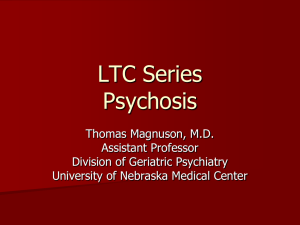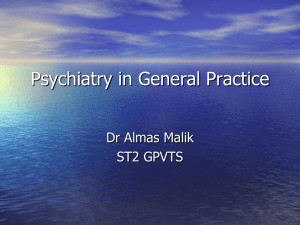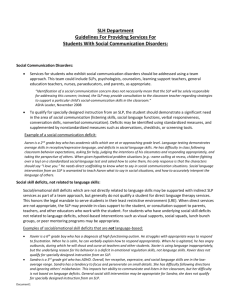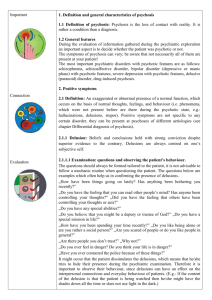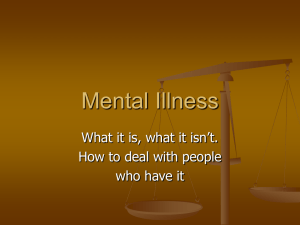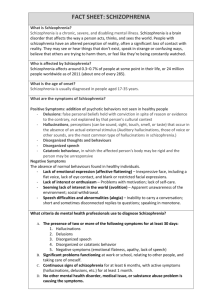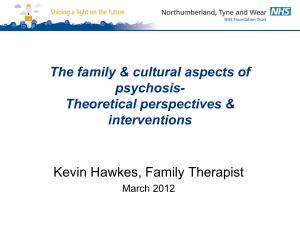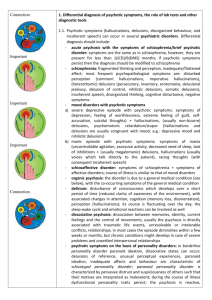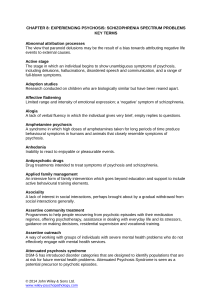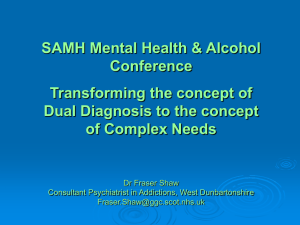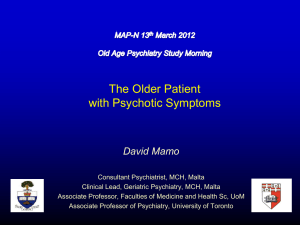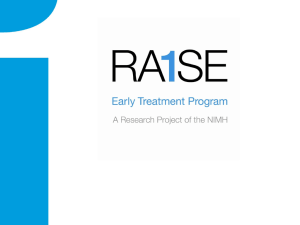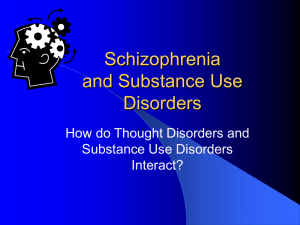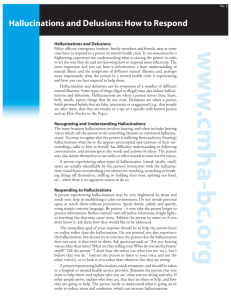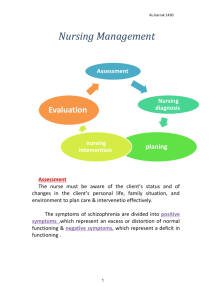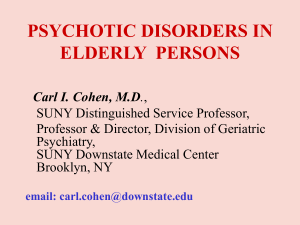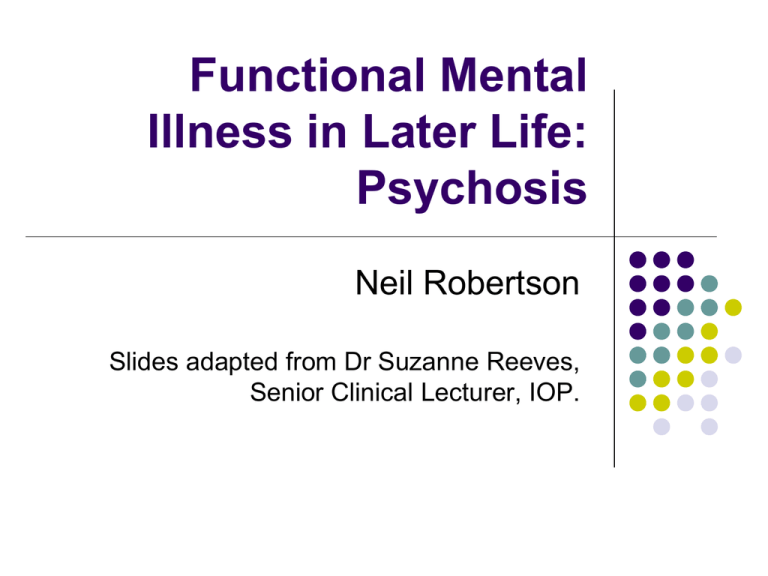
Functional Mental
Illness in Later Life:
Psychosis
Neil Robertson
Slides adapted from Dr Suzanne Reeves,
Senior Clinical Lecturer, IOP.
Psychosis
Psychosis is an umbrella term for a number
of psychotic illnesses that include:
Drug induced psychosis
Organic psychosis
Bi-polar disorder
Schizophrenia
Psychotic depression
Schizo-affective disorder
(Taken from EPPIC)
Psychosis is characterised by:
Hallucinations – sensory perceptions in the
absence of external stimuli – Types?
Delusions – a belief held with strong conviction
despite evidence to the contrary
Formal Thought Disorder - presenting with
incomprehensible thought patterns and/or
language
Catatonia - state of neuro-genic motor
immobility, and behavioural abnormality
manifested by stupor, over-activity or rigidity
Negative symptoms
Blunted affect
Poverty of speech
Anhedonia
Lack of desire to form relationships
Lack of motivation
Psychotic Depression
Prevalence ~2%
-35% of older inpatients
- 5% of young adults
Delusions
- persecutory, hypochondriacal, poverty
Hallucinations
- 2nd person auditory, olfactory, gustatory
Co-morbidity - physical co-morbidity in older
compared to young adult patients
Alcoholic Hallucinosis
History of excessive alcohol intake
2nd person auditory hallucinations most common
Persecutory ideas/ideas of reference
~ co-morbid depressive symptoms
~ cognitive impairment
Onset after 60 non-organic, non-affective
Late-onset schizophrenia
Late life psychosis
Schizophrenia
Classification and Incidence
Late-onset schizophrenia (LOS)
- illness onset > 40 yrs
-12.6 per 100 000 population per year
Very-late-onset schizophrenia-like psychosis (SLP)
- illness onset > 60 yrs
- 17-24 per 100 000 population (Holden et al, 1987)
Criteria for SLP
Onset > 60 years
Presence of fantastic, persecutory, referential, or
grandiose delusions +/- hallucinations
Absence of primary affective disorder
MMSE >24/30
No clouding of consciousness
No history of neurological illness/alcohol dependence
Normal blood chemistry
(see Howard et al, 2000)
People with SLP have all the symptoms of
schizophrenia except for...
Formal thought disorder
Negative symptoms
Plus some extra symptoms….
Complex
visual hallucinations
Partition
delusions
Phenomenology of SLP
Non-verbal auditory hallucinations 70%
3rd person auditory hallucinations 50%
Hallucinations in other modalities 30%
Delusions
persecution 85%
reference 75%
misidentification 60%
partition 70%
Formal thought disorder, negative symptoms rare
(<5%) and may represent misdiagnosed cases
Partition Delusions
Watched /overheard
through partition 40%
Human intruder to home
+-theft 34%
Non-human intrusion –
gas/radiation 30%
Somatic effect of intrusion
20%
Howard, R et al (1992). Int J Geriatr Psychiatry 7; 719-724
PERMEABLE WALLS, FLOORS, CEILINGS AND DOORS.
PARTITION DELUSIONS IN LATE PARAPHRENIA
A partition delusion is the belief that people, objects or radiation can
pass through what would normally constitute a barrier to such
passage. These delusions have been reported to be common in late
paraphrenia and late-onset schizophrenia. Such partition delusions
were found in 68% of 50 patients with late paraphrenia, but only in
13% of patients with schizophrenia who had grown old and in 20% of
young schizophrenics.
SLP: Cognitive Outcome
25% cognitive impairment consistent with
a diagnosis of dementia within 3 years
(Holden 1987, Reeves 2001)
75% stable cognitive deficits
Risk Factors for SLP
Age: incidence by 11% for every 5 yr in age beyond
60 years
Female Gender: 4 x higher risk compared to men
- not explained by higher proportion of ‘older’ women
- ?loss of protective effect of oestrogen post menopause
Sensory Deficits : Auditory 40%, Visual 20%
Genetic Factors: more likely to have a FH of affective
disorder
Pre-morbid Personality: paranoid, depressive, anxious
or schizoid traits
Social Cognition Deficits
Deficits in social cognition reported in young adults
with schizophrenia
Believed to represent a reduced ability to process
context-based information
People with SLP report similar deficits in ‘executive
function’ as young people with schizophrenia
Social processing - mentalising (understanding the
intentions of others) - also affected in SLP (Moore et al,
2006)
Other possible risk factors for SLP
As yet unidentified biological factor vulnerability towards
SLP
Genetic loading for affective disorder
Female sex
Increasing age
Migrant status
Unmarried state and isolation
Specific deficits in social cognition
Treatment of SLP
Summary:
Pharmacological: No RCTs but observational studies
suggest that low dose antipsychotic medication is
effective
Psychosocial: Observational studies suggest that
engagement with a keyworker and increasing positive
social interactions may improve outcome
Psychosocial aspects of treatment
Aim to increase positive social
interactions
- Correcting sensory deficits may reduce the
risk of misinterpretation of others’
- Increase social outlets,encourage attendance
at hospital/luncheon club
- Allocating a keyworker/care co-ordinator to
facilitate this and to monitor mental state
When to Intervene..
3 reasons to intervene: When symptoms are causing
distress to the point where the person is at risk of
(i)
Self-harm
(ii)
Self-neglect
(iii)
Retaliation against the ‘perpetrator’
When not to intervene:
When the person is refusing treatment AND the risks are
low in terms of self or others.



